So, you’ve decided that paid advertising and PPC is the right choice to gain some quick wins for your brand. Excellent move! One of the great perks of PPC is that it gives you the ability to see fast results and also make adjustments to improve your success. But if you aren’t tracking the right metrics, how will you know what changes need to be made to give your ROI a lift? Don’t worry, because we’re here to fill you in.
If you’ve been down this road before, you might have faced some obstacles in calculating the ROI of your PPC campaign accurately, and you’re definitely not alone in that.
![]()
Fortunately, we can get you back on track with the metrics that matter. We’re starting our countdown with 9 tips to ramp up your ROI, 8 metrics you need to be tracking, and 7 formulas that will help you measure your performance. But before you break out the calculators, let’s find out how to achieve greater ROI with your PPC campaigns.
9 Tips to Improve ROI on PPC
Let’s start with the good news: PPC delivers fantastic ROI. The only bad news is that the results only continue as long as your budget lasts. That means you need to maximize your ad spend to get the most out of your campaign. Here’s how to do it:
#1: Consider using exact match keywords
Keywords lay the foundation for your PPC campaign. You can create an entire list of targeted keywords and variations, but depending on your industry and your market, you might be better served by limiting your keywords to exact matches only.
It means less reach (so it’s not appropriate for a brand awareness campaign), but it also means that the people who see your ad are searching for precisely what you’re offering. This high search intent also leads to a higher conversion rate.
#2: Use negative keywords
This is sort of the reverse psychology of PPC advertising. Sure, you want to pick the best keywords so your ad gets in front of the right audience. But you also want to pick the worst keywords so your ad doesn’t make it to the wrong audience.
Here’s how it works: You choose the keywords you absolutely don’t want your ad associated with, and anyone searching for those terms will be excluded from seeing it. For example, let’s say you sell pet supplies for reptiles. You probably don’t want pet owners searching for “dog supplies” or “cat supplies” to see your ad because they aren’t very likely to take action. Those are your negative keywords.
#3: Use ad extensions
Ad extensions are such an easy — but often overlooked — way to make your ads stand out. Use extensions to add your location, product reviews, form fields, and even a call button to your PPC ad. As an added bonus, more extensions mean more space. And the more space your ad takes up, the more likely you’ll be to elbow out the competition.
#4: Improve your quality score
If you’re advertising on the Google network, your quality score (QS) is critical to where your ad is placed. Better QS, better placement. To determine your quality score, Google looks at the overall quality of your ad, how many conversions it has, and how relevant your landing page is. To improve QS, make sure your ad has strong copy, great creative, and a compelling offer. Then, optimize your landing page for your selected keywords.
#5: Time your ad perfectly
Part of your ad targeting includes selecting the time in which it will appear. Depending on your industry and your target audience, it’s a great way to boost conversions. Let’s say you sell infant clothing and developmental toys. You might want to run your ads during off-peak hours (i.e., the middle of the night) to reach tired moms up with their babies.
Or, maybe you sell fan gear — you’ll want more ads running during major sporting events. Think of your buyer persona and dig deep into their habits and behaviors to determine the best timing for your campaign.
#6: Use keywords in ad copy
A lot of advertisers agonize over their targeted keywords…but completely miss using them in their ad copy. You won’t get dinged on ad placement if you don’t feature your keywords front and center. However, you’re missing a big opportunity. You chose your targeted keywords because you believe that’s what your audience is searching for. Placing those terms in your ad copy acts as a giant beacon that tells your audience they’re heading in the right direction.
#7: Personalize landing pages for each audience
Creating a high-quality, highly-clickable ad is only half the battle. In fact, if you’re focusing more on your ad than you are on your landing page, you might find yourself facing the unenviable reality of quickly declining ROI. Your landing page plays an incredibly significant role in your conversion rate, so it must be optimized for your keywords, relevant to the ad, consistent in the offer, and easy for visitors to navigate and take the desired action. If you have different buyer personas, you’ll probably want to create a landing page for each, with messaging that appeals to them.
#8: Track stats and improve based on data
If you’re running a campaign with Google Ads, you’ll get a lot of powerful data right on your dashboard. These metrics can tell you how your ad is performing and where adjustments need to be made. If your click-through rate (CTR) is dropping, something in your ad needs to change. If your conversion rate tanks, you probably want to take a fresh look at your landing page. Further down, we’ll go into detail on what and how to track this data so you’re ready to make informed decisions.
#9: Aim for long-term results
We have a confession to make: we’re pretty guilty of looking at PPC as a short-term approach to gaining quick growth. And it certainly can be that, but it can also be a long-term strategy. In fact, the longer you run PPC campaigns, the greater your ROI will be. As you make adjustments and find the right combination of copy, creative, and offers that work, your conversion rate will rise. That means your quality score will improve, and you’ll get better placement and better results.
A Few Expenses to Consider When Calculating PPC ROI
Ya gotta spend money to make money, amiright? But what happens if you’re sinking too much of your budget into something that doesn’t pay off? You’ll want to keep a close eye on what you’re spending when launching your PPC campaign. PPC typically boasts great ROI, but it can also be a money pit — especially knowing that as soon as you stop spending, you stop seeing results. So consider these expenses as you’re building your PPC budget and preparing to track your ROI:
💲 Technology cost
This will mostly be different software and programs you use to prep your PPC campaign, like SEO and keyword tools. You can also purchase PPC software, which is beneficial if you want an automated way to launch campaigns across ad networks.
💲 Ad spend
This is how much you’re bidding for ad placement across your networks and can vary quite a bit based on a variety of factors, such as keywords, peak or off-peak time, market competition, and industry.
💲 3rd-party costs
This includes whether or not you’re using an outside agency, partner, or contractor to support your PPC efforts. You’ll need to be sure that everything you’re paying is factored into your calculations to accurately determine your ROI.
💲 Labor costs
If you’re managing an internal marketing team, don’t forget to include the labor costs of your employees. If they’re at all involved in developing or implementing your PPC campaigns, their time must be factored in.
8 Important Metrics to Consider When Calculating PPC ROI
We’ll get to the equations and formulas in a moment, but first, it’s important that you know exactly what you need to be tracking in order to keep tabs on your PPC ROI.
#1: Clicks
Clicks are probably the first metric you’ll notice when launching a PPC campaign. And when they start rolling in, you might be tempted to declare your foray into paid ads a success. Clicks are great, of course, because they offer proof of performance — your ad is good enough to get people to take action. However, you need to weigh your clicks against your conversions because if both aren’t going up, there’s a problem.
#2: Cost per click
All those clicks are great, but if your cost per click (CPC) is high, you’re going to use up your budget before you can see any significant results. To lower your CPC, you can focus on long-tail keywords that offer high search intent so those who click on the ad are more likely to convert.
#3: Conversion rate
Speaking of conversions, your conversion rate is a percentage of how many people click on your ad and then go on to take your desired action (fill out a form, make a purchase, etc.). A high conversion rate can bring down your CPC, and it can also improve your quality score, which will raise your ROI over time.
#4: Traffic and CTR
Monitoring traffic on your campaign landing page is a critical way to determine how your ads are performing. Understanding your click-through rate (CTR) will help you determine if you need to make adjustments to your ad’s creative, copy or offer.
#5: Quality score
Quality score is determined by Google and is based on your CTR, conversion rate, ad quality, and relevance. QS is rated on a scale of 1-10, and the higher your score, the better ad placement you’ll receive. This is how QS is directly tied to your PPC ROI.
#6: Impression share
A little-known but extremely useful metric, impression share is the percentage of impressions your ad receives versus the impressions for which it was eligible. So, if your ad is eligible for 1,000 impressions, but you receive 600 impressions, you’re only getting 60 percent impression share. To boost your share, you may need to consider raising your bids and/or increasing your campaign budget.
#7: Cost per conversion
CPC is the total cost to you for every person who takes your desired action. Let’s say your total campaign cost was $500, and during the campaign, 50 people went through the funnel all the way to conversion. That means your CPC is $10. Of course, you want your CPC to be as low as possible, but that sweet spot will vary based on many factors, including how much a conversion or sale is worth for your brand.
#8: Total conversion value
To track this metric, you’ll need to assign a value for conversion in your campaign. That might be the revenue you earn for a particular sale or offer, or it may be the value of acquiring a qualified new lead. Whatever it is, you’ll see the final sum as your total conversion value.
7 Formulas to Calculate the ROI of PPC
Ready to put your math cap on? You don’t need to be Einstein to understand these equations, but if they feel overwhelming, read on to learn more about finding a trusted partner to support you in achieving your PPC goals.
#1: Return on ad spend
There’s a very important distinction between ROI and return on ad spend (ROAS). ROI takes into account your total investment (including the cost of doing business), while ROAS looks only at the profitability of your campaign based on what you’re spending on ad placement.
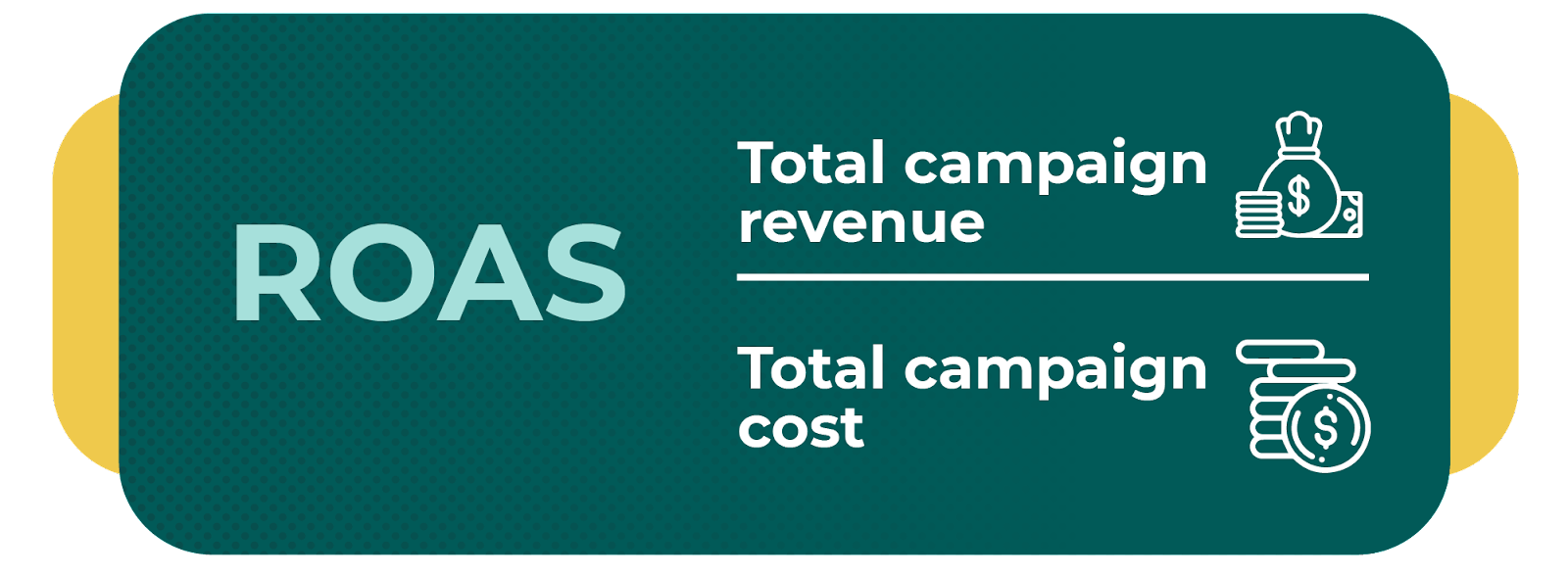
Tracking ROAS won’t give you a complete picture of your PPC campaign’s success, but it is still an important part of understanding your ad performance and will help you make decisions on bidding and budgeting.
#2: ROI
Calculating your return on investment is probably the most important thing you’ll do in determining whether or not a PPC campaign was successful. To determine ROI, you’ll look beyond the ad spend and incorporate all expenses, including labor, technology, and third-party support. First, you’ll take your overall profit and subtract the total cost (ad spend plus cost of doing business), then divide it again by the total cost and multiply x100.
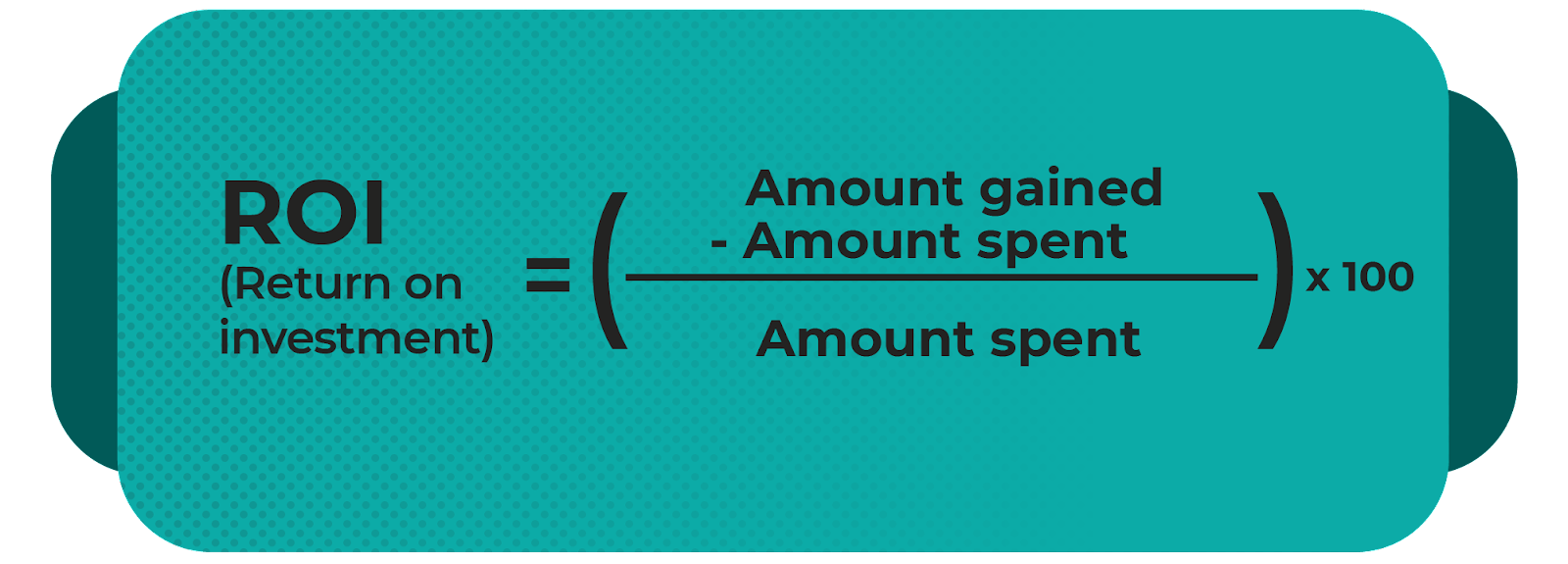
Remember that ROI is expressed as a percentage. If your ROI isn’t where you want or expect it to be, you’ll want to look at all the factors, including your ROAS and your cost of doing business. If ROAS is high, but ROI is low, you may want to look for ways to reduce business costs.
#3: Break-even return on ad spend
Knowing your ROAS is great, but do you know exactly what you have to make on your ad spend to get your money back? For that, you’ll need to determine your break-even return on ad spend, or B/E ROAS. To do this, you’ll need to know your profit margin on the product or service you’re selling with your ads.
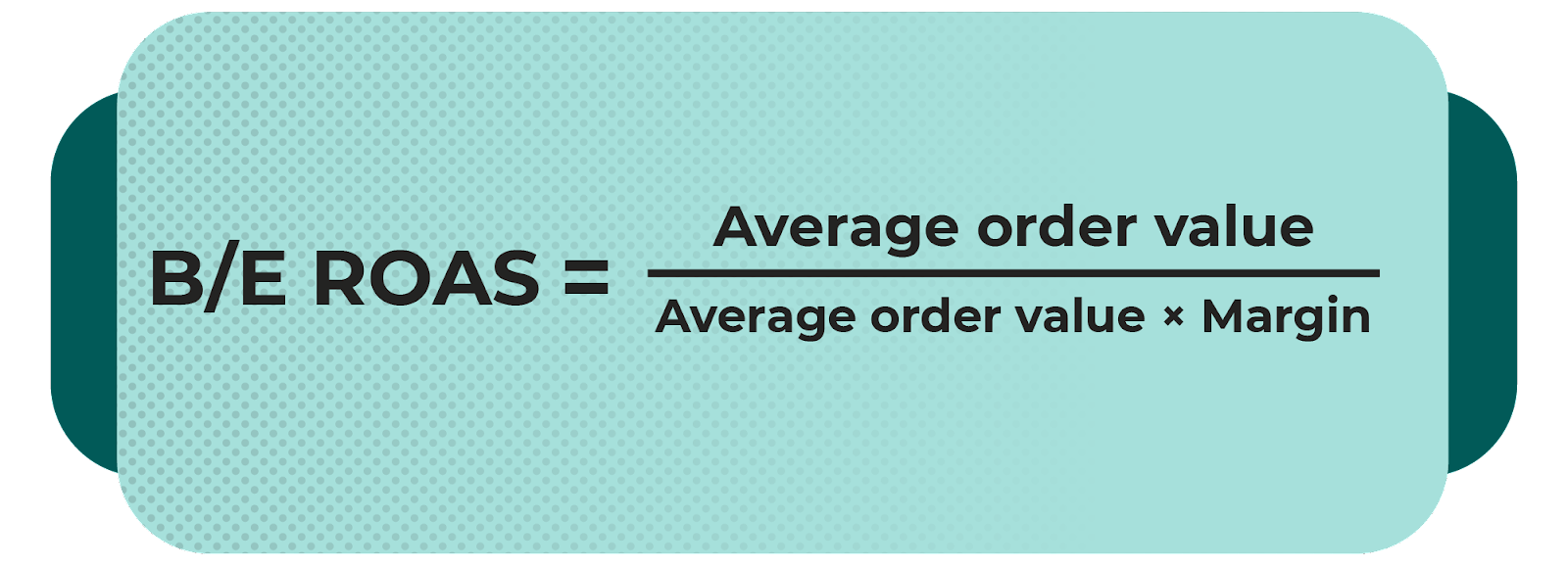
When you calculate your B/E ROAS, you’ll know exactly how much you’ll need to make on your campaign to break even before you start turning an actual profit.
#4: Cost per conversion for forms
Let’s say the goal of your PPC campaign is to generate leads by getting them to complete a form. When you aren’t earning revenue from sales, how do you know how your campaign is performing? To determine your cost per conversion for forms, you’ll have to first figure out your total cost per conversion (based on form fills that actually turn into sales) using this formula:
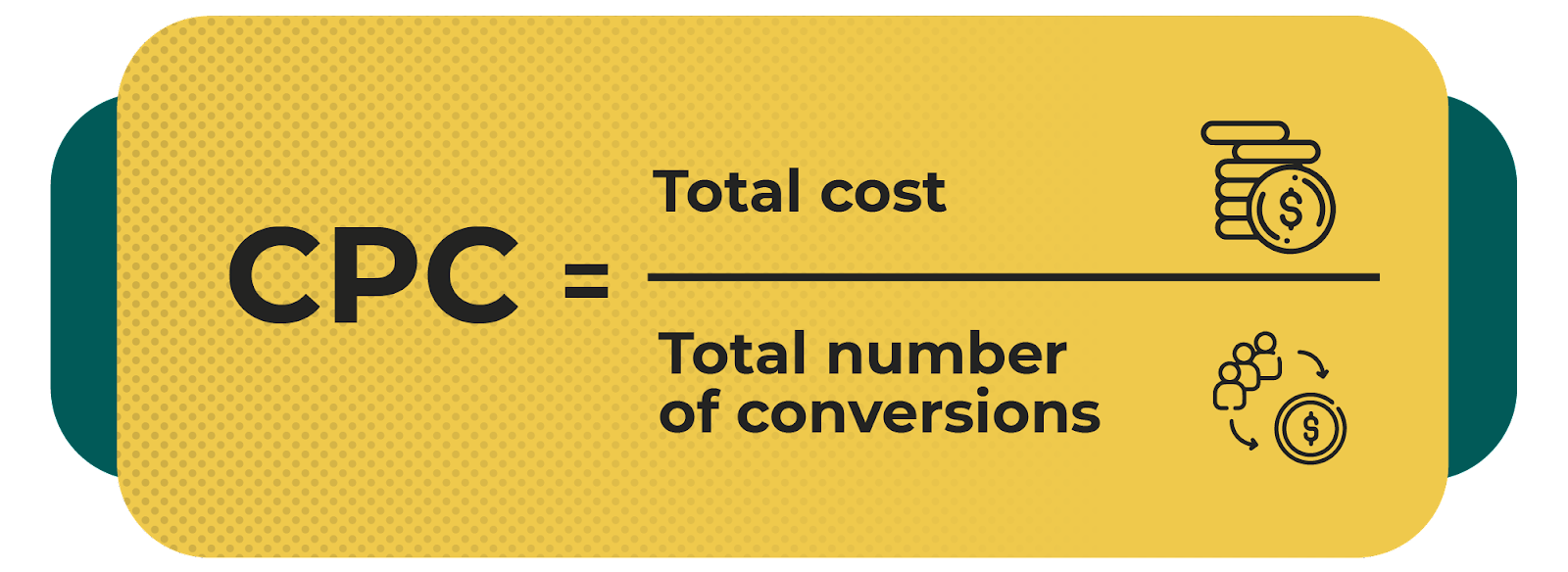
Next, you need to know your form conversion rate — the percentage of forms that turn into sales. Once you have that, divide your total cost per conversion by your form conversion rate, and you’ll have your CPC for forms.
#5: Break-even cost per conversion for forms
Taking your form conversion rate from above, you can determine your break-even CPC for forms.
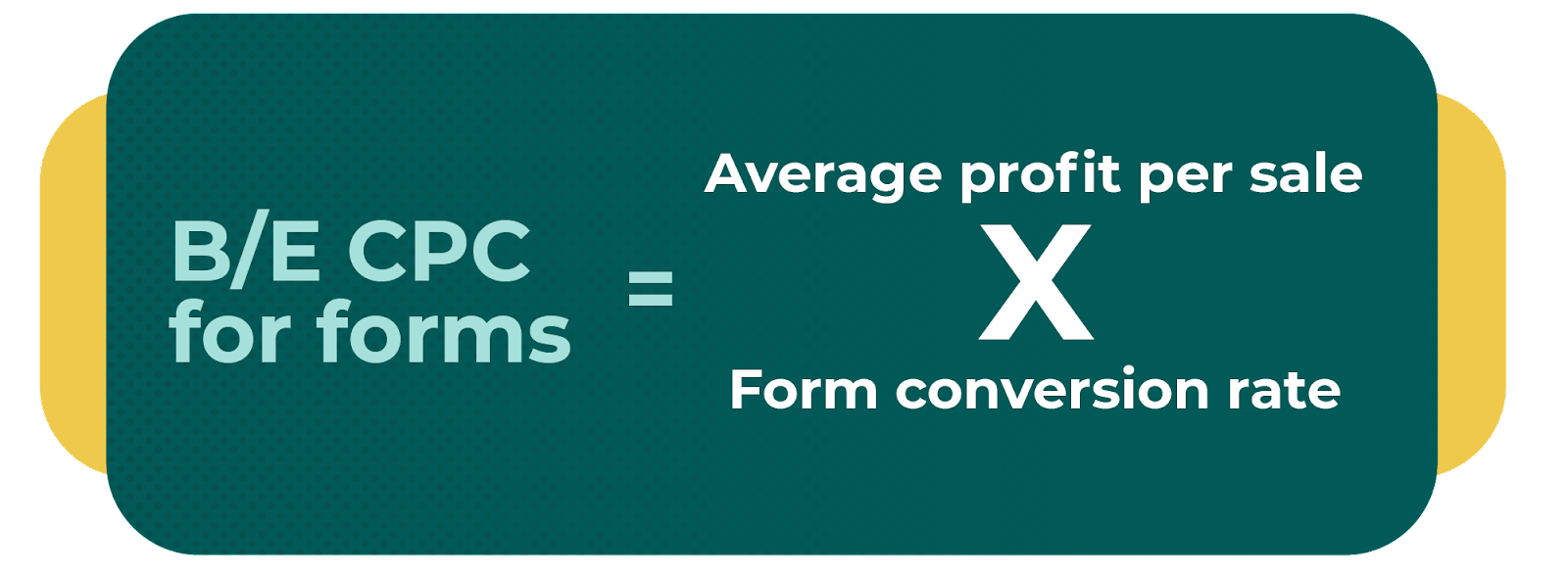
Now you know how much you need to make per conversion to earn back your investment.
#6: Profit per impression/click
Here are a couple of simpler formulas after those head-scratchers! You want to know exactly how much you’re earning every time someone sees your ad and/or clicks on it. First, calculate your revenue per thousand impressions (RPM):
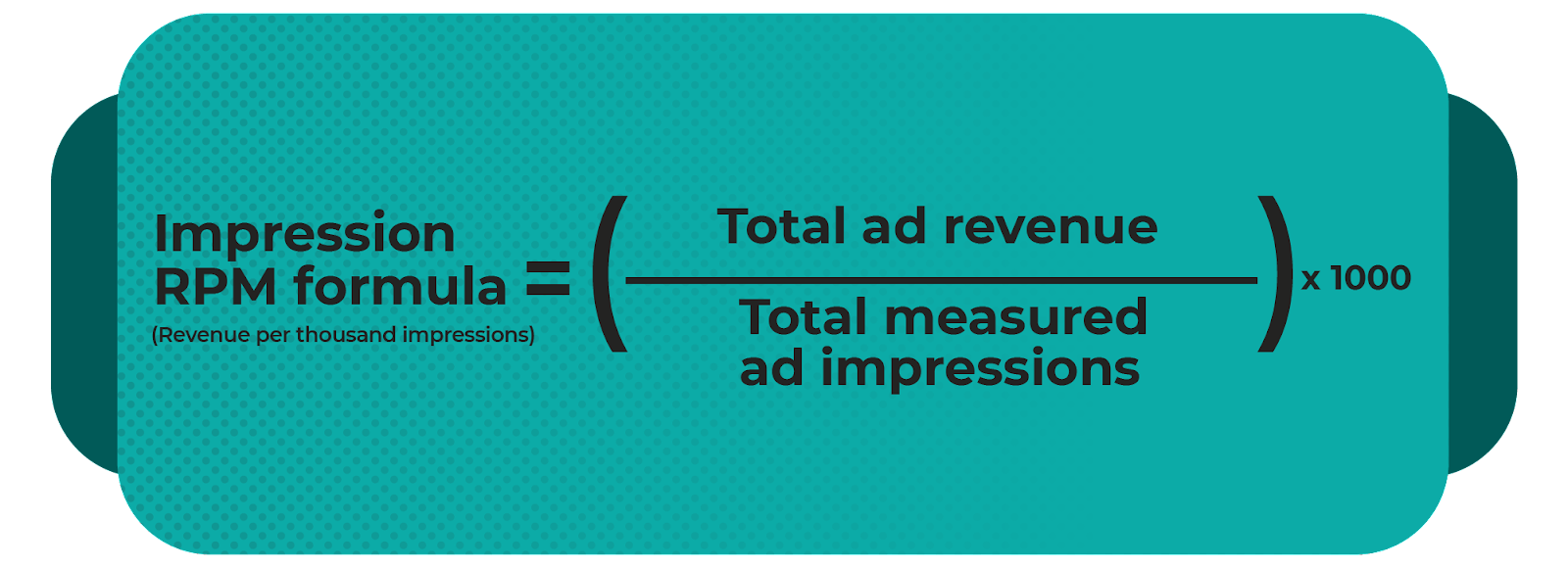
And then, to calculate your profit per click, there’s a very basic equation:
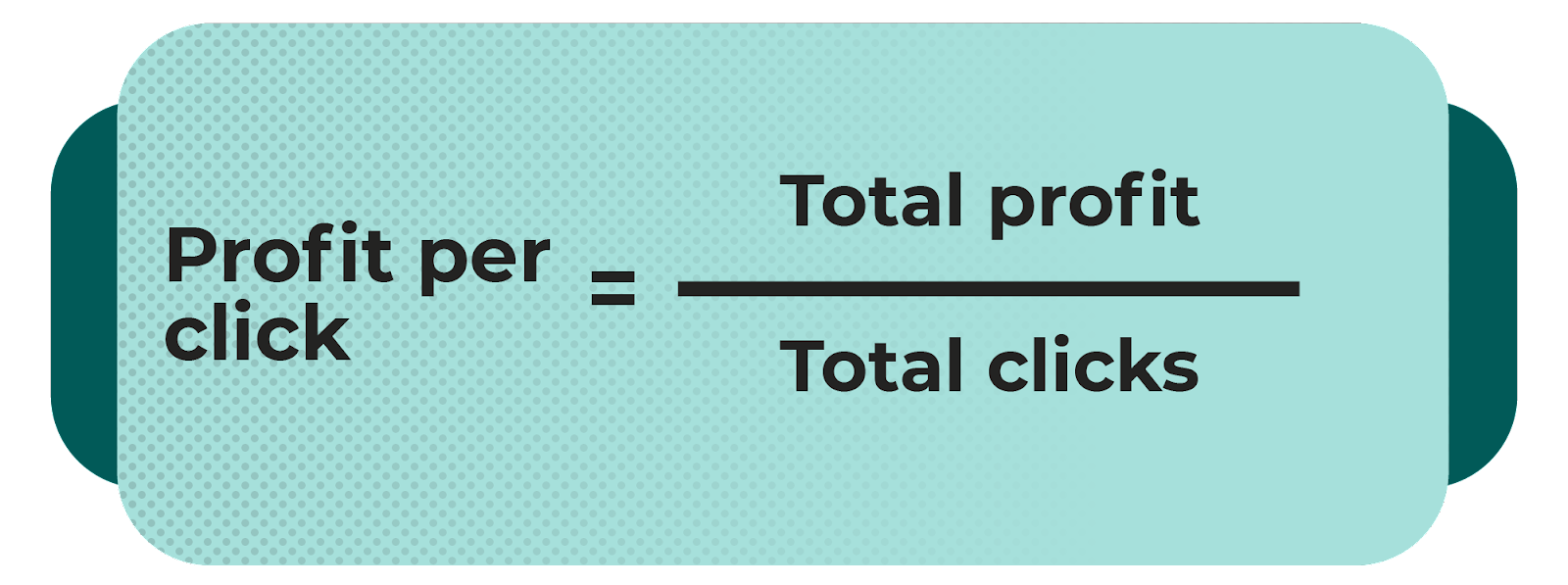
Remember that for both of these, you’ll need to determine your total profit — which is your total sales value minus total cost.
#7: Break-even cost per conversion for complex sales cycles
Let’s say your PPC campaign results in revenue, but it’s not a straightforward path to get there. So, visitors click on an ad for a free course — that’s your conversion. However, at least some of those visitors will go on to the next level paid course. From there, some might purchase the software to utilize their new skills.
So what in the world is your actual CPC??
This is where you might need to do some mental gymnastics. Work backward to determine the conversion rate for the free course, then determine the rate at which those users upgrade to the paid course. The formula will look like this:
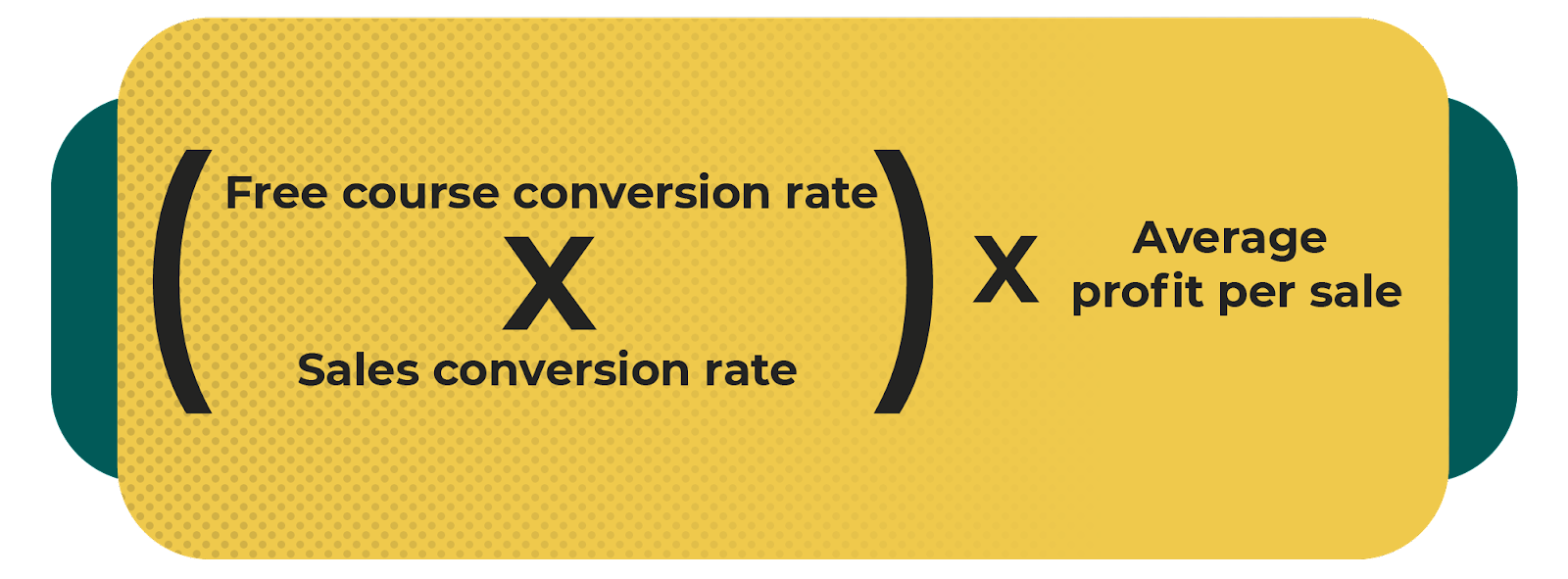
Which Method Is Best for Calculating PPC ROI?
Take a deep breath because that was A LOT. Whether you’re a numbers person or not, it can be overwhelming and frustrating to keep tabs on all these formulas and calculations. And the answer to the above question is that there isn’t a best method — you’ll want to use all of them to gather maximum insights and make smart decisions to drive results.
That’s where a trusted partner in PPC comes in really, really handy. At FPS, we can incorporate PPC as part of an overall growth marketing strategy designed to get you both quick wins and long-term, sustainable growth. And, as a bonus, we take care of all the analytics, equations, calculations, and math-y stuff, so you don’t have to!







